|
Diospyros whyteana (Bladdernut)
[= Royena whyteana, Royena lucida]
Bostolbos, Swartbas [Afrikaans]; Mohlatsane [North Sotho];
Nyapahuro, Nyatsipa [Shona]; Munyavhili [Venda]; umTenatane [Xhosa]; uManzimane, umKahze [Zulu] Life
> eukaryotes >
Archaeoplastida >
Chloroplastida
>
Charophyta > Streptophytina > Plantae (land plants)
> Tracheophyta (vascular plants) > Euphyllophyta > Lignophyta (woody plants)
> Spermatophyta (seed plants) > Angiospermae (flowering
plants) > Eudicotyledons > Core Eudicots > Asterids > Order: Ericales > Family: Ebenaceae > Genus:
Diospyros
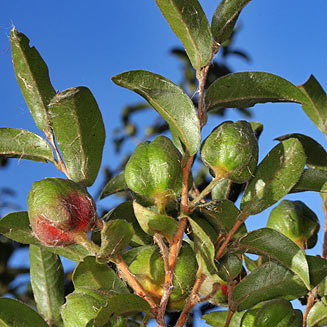 |
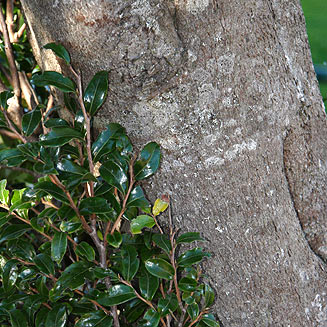 |
| Leaves and
bladder-enclosed fruit of Diospyros whyteana. Note sparse long
hairs on underside of leaves. [photo H. Robertson
©] |
Leaves and trunk of Diospyros
whyteana. [photo H. Robertson ©] |
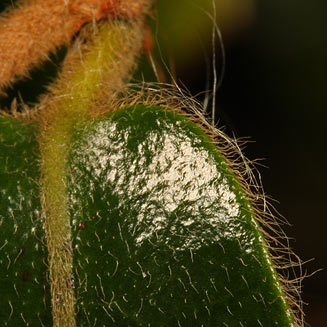 |
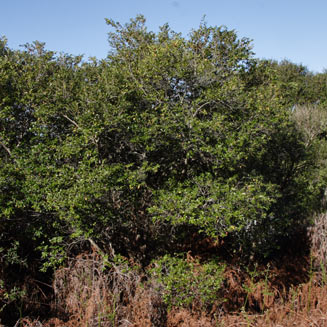 |
| Close-up of upper-side
of Diospyros whyteana leaf at base showing fringe of
reddish-brown hairs along the margin. [photo H. Robertson
©] |
Diospyros whyteana tree,
Kirstenbosch Botanical Gardens, Cape Town. [photo H. Robertson, Iziko
©] |
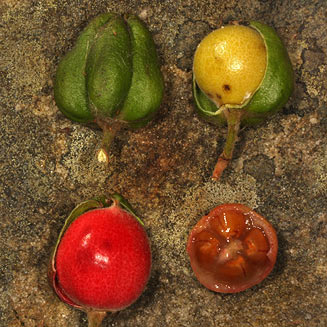 |
 |
| Fruit of Diospyros
whyteana: top left, with bladder (derived from calyx) intact; top
right and bottom left - mature fruit with bladder partly removed; bottom
right - top down view of fruit showing the four seeds embedded in a
jelly-like matrix. [photo H. Robertson ©] |
Seeds of Diospyros whyteana.
[photo H. Robertson ©] |
Description
Shrub or small tree growing from 2-7 m high. Leaves are
glossy dark green above and pale below with a distinctive fringe of reddish-brown hairs
along the margin (not apparent on old leaves). There are sparse, long hairs on
the underside of leaves. Dioecious, in that there are separate male and female flowers
on separate plants (monoecious species have separate male
and female flowers but they are on the same plant; most flowering plants have
hermaphroditic flowers where each flower has male and female components). The common name 'Bladdernut' is derived
from the fact that as the fruit matures, the sepals of the calyx grow to form an
inflated, papery, bladder-like structure round the fruit, in a similar manner to
the Cape gooseberry. The
fruit is about 1.5 cm long and becomes red when ripe.
Distribution and habitat
Has a wide distribution extending from Cape Town to
Ethiopia. Occurs in scrub, riverine thicket and Afromontane forest, often in
rocky areas.
Derivation of name
The genus name 'Diospyros' is derived from Greek and
means divine pear. The species name 'whyteana' is in honour of Alexander
Whyte (born 1834, died 1908), who was a Scottish horticulturist and plant
collector. In Malawi he was Government Botanist in Sir Harry Johnston's
Administration, from 1891 and 1895.
Uses
-
A popular garden tree. This species has been selected,
along with Markhamia
zanzibarica (Bell bean tree) and
Harpephyllum caffrum
(Wild plum) as Tree of the Year for 2008 (see more on
Department of Water Affairs and Forestry website). For information on
how to grow it, see
PlantzAfrica.com.
-
The wood is hard and heavy and used to make handles of
implements. The genus Diospyros includes species that produce the
dark, heavy wood called ebony but Diospyros whyteana is not one of
these.
-
Seeds have been known to be used as a coffee
substitute.
-
Bark extracts are used as enemas for treating
impotency, infertility and menstrual pain.
-
An infusion from the leaves and roots is used for
treating rashes.
-
Leaves are browsed by game.
Links
References
- Schmidt, E., Lotter, M., McCleland, W. and Burrows, J.E. 2002. Trees
and Shrubs of Mpumalanga and Kruger National Park. Jacana, Johannesburg.
Text by Hamish Robertson |
